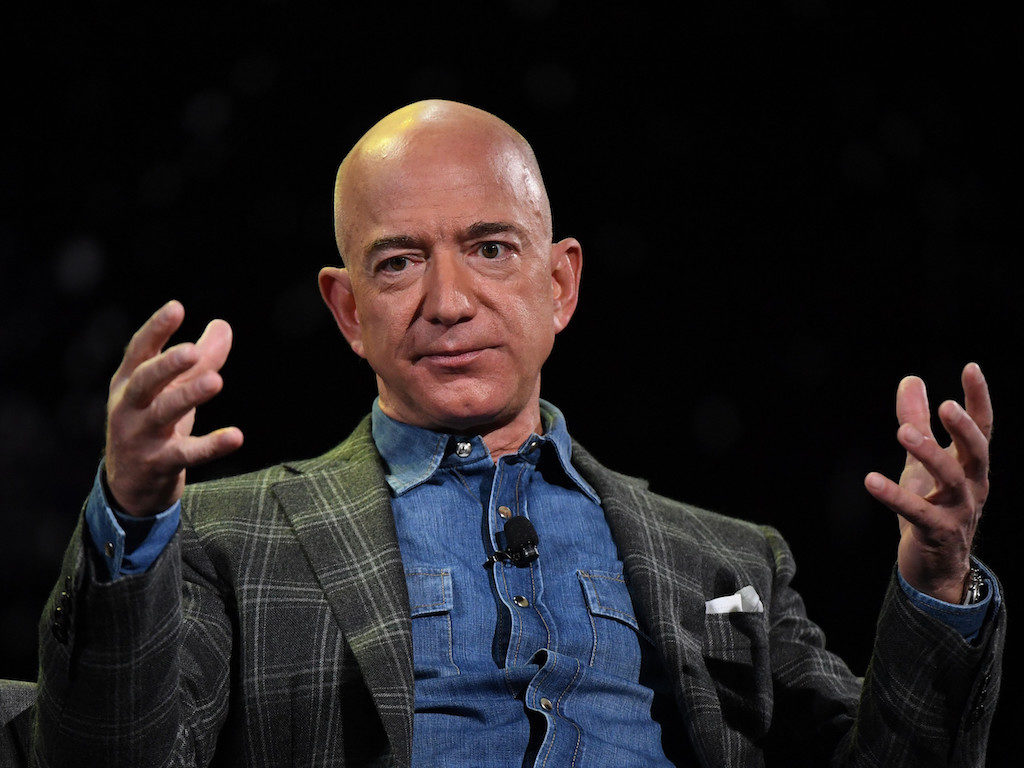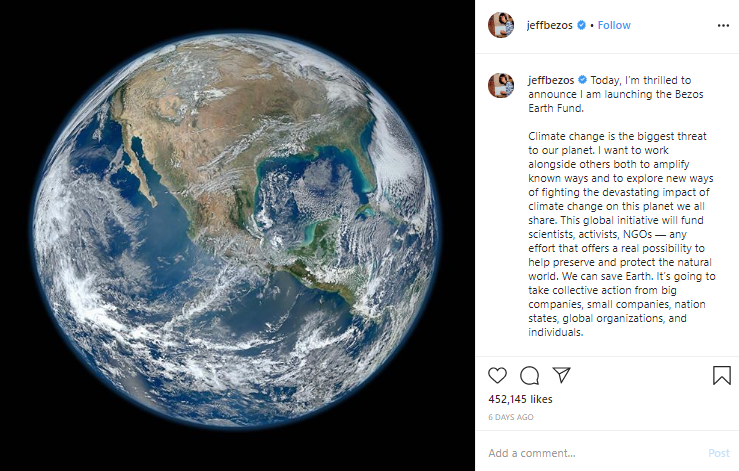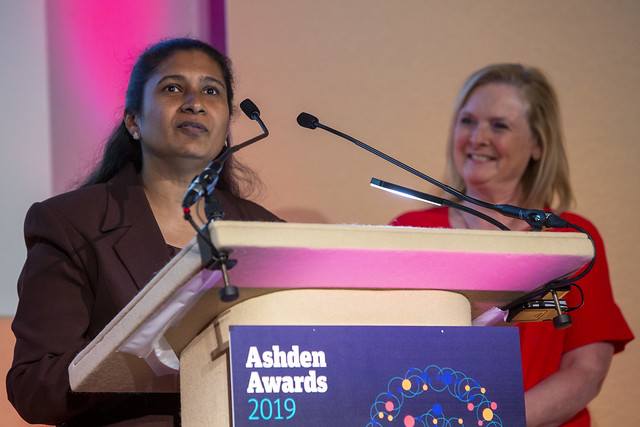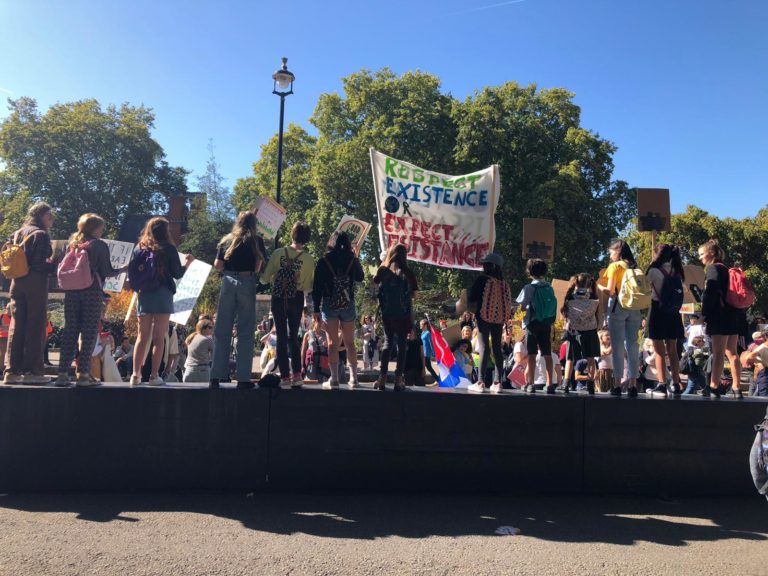The $10 billion question—can Bezos throw money (effectively) at our climate problem?
28 February 2020, Dr Jasmine Hyman, Category: All insights, News, Tags: bezos earth fund, climate change, Climate crisis, climate finance, Climate justice, Green Climate Fund, insights, jeff bezos

Feature image credit: Mark Ralston / Getty Images.
E Co. Principal consultant Dr Jasmine Hyman comments on the recent announcement by retail giant Amazon’s founder, Jeff Bezos, and the launch of his eponymous Earth Fund. Read Jasmine’s thoughts below on how the funds could be channeled to support existing climate finance mechanisms and initiatives.
Last Tuesday, Jeff Bezos took to Instagram and pledged 10 billion dollars to help fight the impacts of climate change:

Today, I’m thrilled to announce I am launching the Bezos Earth Fund.
Climate change is the biggest threat to our planet. I want to work alongside others both to amplify known ways and to explore new ways of fighting the devastating impact of climate change on this planet we all share. This global initiative will fund scientists, activists, NGOs — any effort that offers a real possibility to help preserve and protect the natural world. We can save Earth. It’s going to take collective action from big companies, small companies, nation states, global organizations, and individuals.
I’m committing $10 billion to start and will begin issuing grants this summer. Earth is the one thing we all have in common — let’s protect it, together.
– Jeff
In the week that has followed, Verge, Vox, The Economist, the Guardian, are all piling in to tell Jeff Bezos how to best spend the cost. It’s a fascinating phenomenon, with some pundits criticising the rich for running for the hills while throwing gold down to the masses from their wagon, and others pandering to the “tycoon,” asking for help with legal fees.
E Co, works with a different USD $10 billion fund (well, $9.8 bn in new pledges, and $5.2 bn in currently dispersed funds): the Green Climate Fund (GCF). Until Bezos entered the scene, the GCF was the largest fund for climate change projects, and it is still the largest public fund for climate change mitigation and adaptation on the planet.
While the Green Climate Fund is far from perfect (check out our quarterly edition of GCF insight for our regular research and surveys on how well the GCF is working, and what it can do to improve)—it’s done a little good in its day and has gained some wisdom in its 10 years of operationalisation. Bezos can surely bypass many of the governance impasses that the GCF encounters, but there is also a serious risk that giving without governance guidelines will end up throwing his money down the drain. In fact, numerous studies on philanthropic giving indicate that philanthropists are rarely effective, because unilateral actions are rarely robust. With that in mind, I’m going to draw from E Co’s specialisation in climate finance to share some of our observations on what works. And Jeff, if you want us to manage your funds directly—just let us know!
1. Funding science and technology
Funding science is certainly worthwhile, and I am sure that schools such as my alma mater, the Yale School of the Environment (formerly, the Yale School of Forestry & Environmental Studies) alongside others are already in discussion with Amazon’s team as to how funds can support research on critical issues such as climate modelling, geo-engineering, adaptation technologies, and slowing biodiversity loss can be better understood.
That said, it is arguable that we already know enough to get the job done. This is not to say that science isn’t critical (or, the critical) element in any strategy to fight climate change, but the true barrier to action is not science but policy. We have the scientific understanding we need to keep ourselves at 1.5 degrees warming, and we have the renewable energy and energy efficiency technologies to get the job done. Where we fail is in disseminating those technologies to those who need it most (Mr Bezos, please consult with the Clean Cooking Alliance for a global case study on the barriers to implementation—even once the science is clear). We fail at supporting long-term policy plans that enable the new scientific breakthroughs to become the norm. Electric mobility has made enormous technical gains of late, but until Ministers of Transport can commit to a 10 or 20 year plan, conventional vehicles will still be the norm.
What does long-term policy making look like? That’s the 100 billion dollar question. But at E Co. we have a small sense of it, because the GCF and other climate funds require evidence that their investment will be sustained over the initial grant-making period. In order to make a grant sustainable, it helps to get policymakers to buy into the process. We hope that Mr Bezos will require evidence of grant sustainability through policy engagement in the projects that he supports.
Takeaway: Invest in science, and invest equally in supporting science policy.

Read our article on the 2019 Ashden Awards Ceremony, supporting and promoting sustainable energy enterprises from around the world. (© Andy Aitchison / Ashden)
2. Funding activists
As Bezos has surely noted, many activists would like funds to make Amazon clean up its act – in terms of encouraging rampant materialism and consumerism, and in terms of the freight and logistics emissions (a sector that currently accounts for more than 7% of global emissions). It would be incredible if some of the USD $10 bn fund was targeted at reducing the global emissions footprint at Amazon first and foremost. E Co. has designed and evaluated multiple country-level projects on greening the logistics sector—again, a policy element is usually the most powerful element of the project’s design.
Many activists become politicians, and rarely (i.e. Al Gore) a politician will turn to activism. A low-tech but demonstrated means of making an effective impact on climate change is to fund and to support the entry of climate-friendly politicians into government. Green parties worldwide could and should benefit from the Bezos Earth Fund. Whether or not one is a fan of Michael Bloomberg in the presidential race, it is difficult to deny that his philanthropic efforts (mostly targeted on campaign support for green politicians) has been one of the largest climate initiatives in the US.
Takeaway: Activists include politicians—invest in getting green voices into government.
3. Non-governmental organisations
The power of non-state actors is an undeniable, powerful force of change. At present, NGOs are needed to help reach those who do not have access to technologies for mitigating and adapting to climate change. In addition, climate change adaptation funds are woefully lacking, in large part because those who are most impacted by climate change are the least able to demand services to fight it.
At E Co. we work hard to include all voices in our climate change project design—we create adaptation funds that are distributed by NGOs so that they can reach farmers and households where the money is needed most. While Bezos will almost certainly support the leaders of the NGO pack (Greenpeace, WWF, Friends of the Earth, among others), it would be very helpful to see earmarked funds for NGOs from areas that lack access to basic needs.
Takeaway: The majority of funds for NGOs should target the global south
Enhancing global participation for a greener future
Finally, at E Co, we’d like to add one more category to the Bezos Earth Fund, so that the USD $10 bn can multiply to the USD $14 trillion required to shift our planet from a fossil-fuel-based to a renewables-based economy. Mr Bezos, please set aside at least a quarter of your philanthropic efforts towards listening to and building coalitions with others. At E Co., we spend the first third of every project just bringing the right people to the table—and that type of early investment pays off.
We have learned from our work with the Green Climate Fund that a unilateral project will fritter away its funds, but projects with real participation, clarity of purpose from governments, academics, scientists, activists, and the private sector, those collaborative projects can demonstrate creative solutions and build a long-term policy vision for a planet that can host us for generations to come.
Want to step up your environmental impact?
When it comes to making a difference, we can all start small. Read Jasmine’s Dos and Don’ts of office recycling as part of our wider initiative to implement our company-wide environmental policy.
Let’s talk
If you’d like to learn more about us and the work we do in climate finance and low-carbon, climate-resilient project design, please don’t hesitate to get in touch with us at amy@ecoltdgroup.com and you can learn more about what E Co. does here.

Join the conversation by posting a comment below. You can either use your social account, by clicking on the corresponding icons or simply fill in the form below. All comments are moderated.